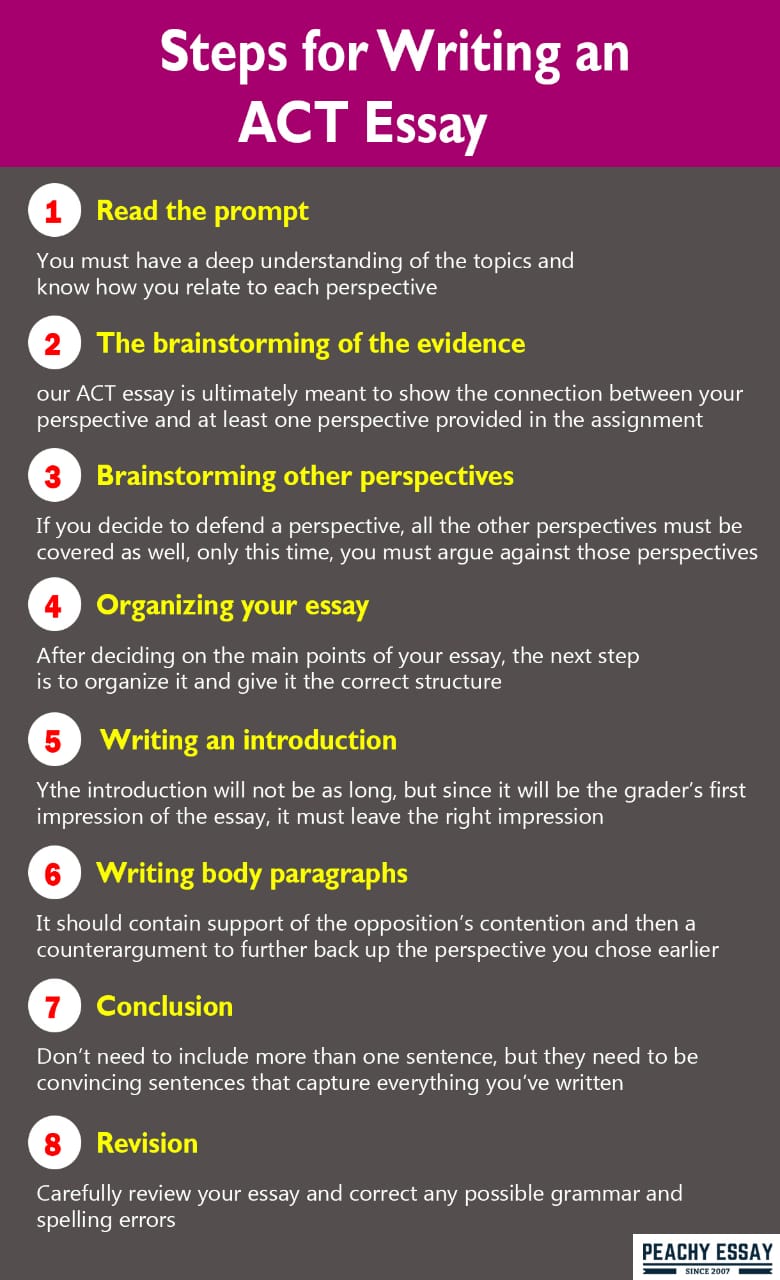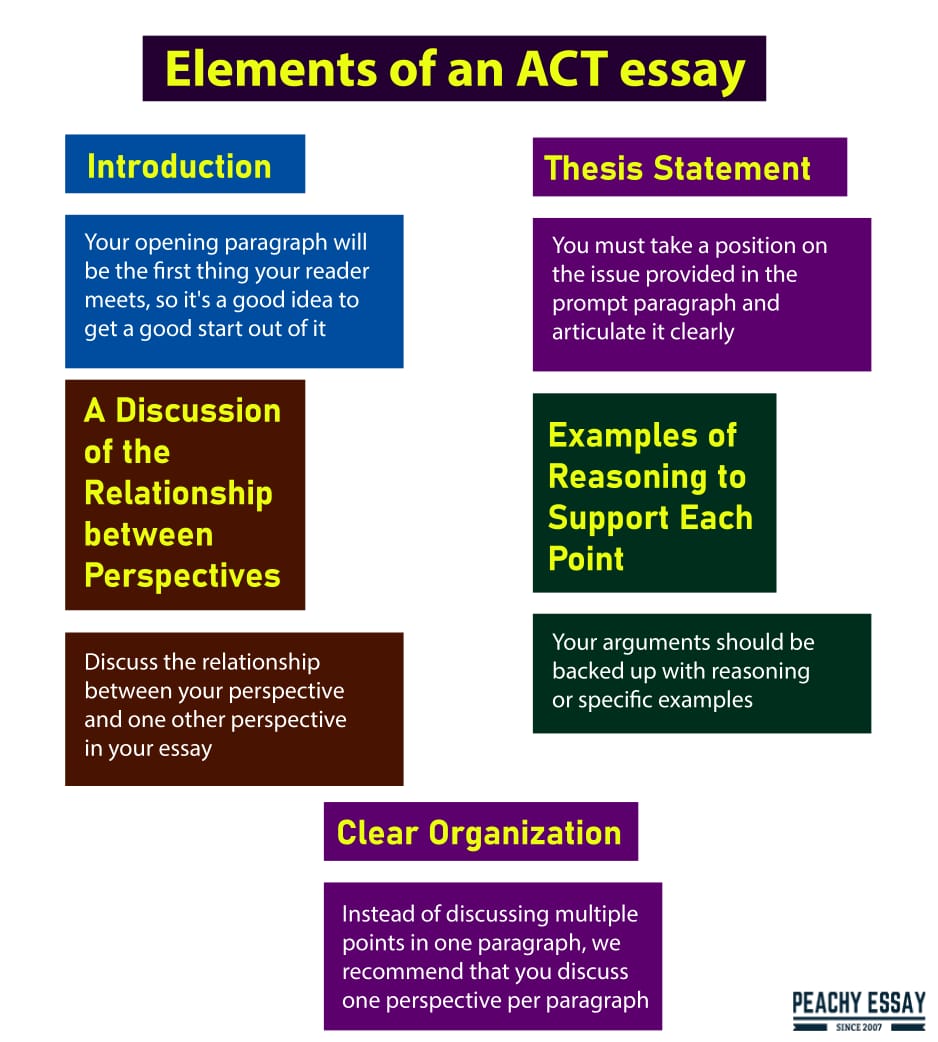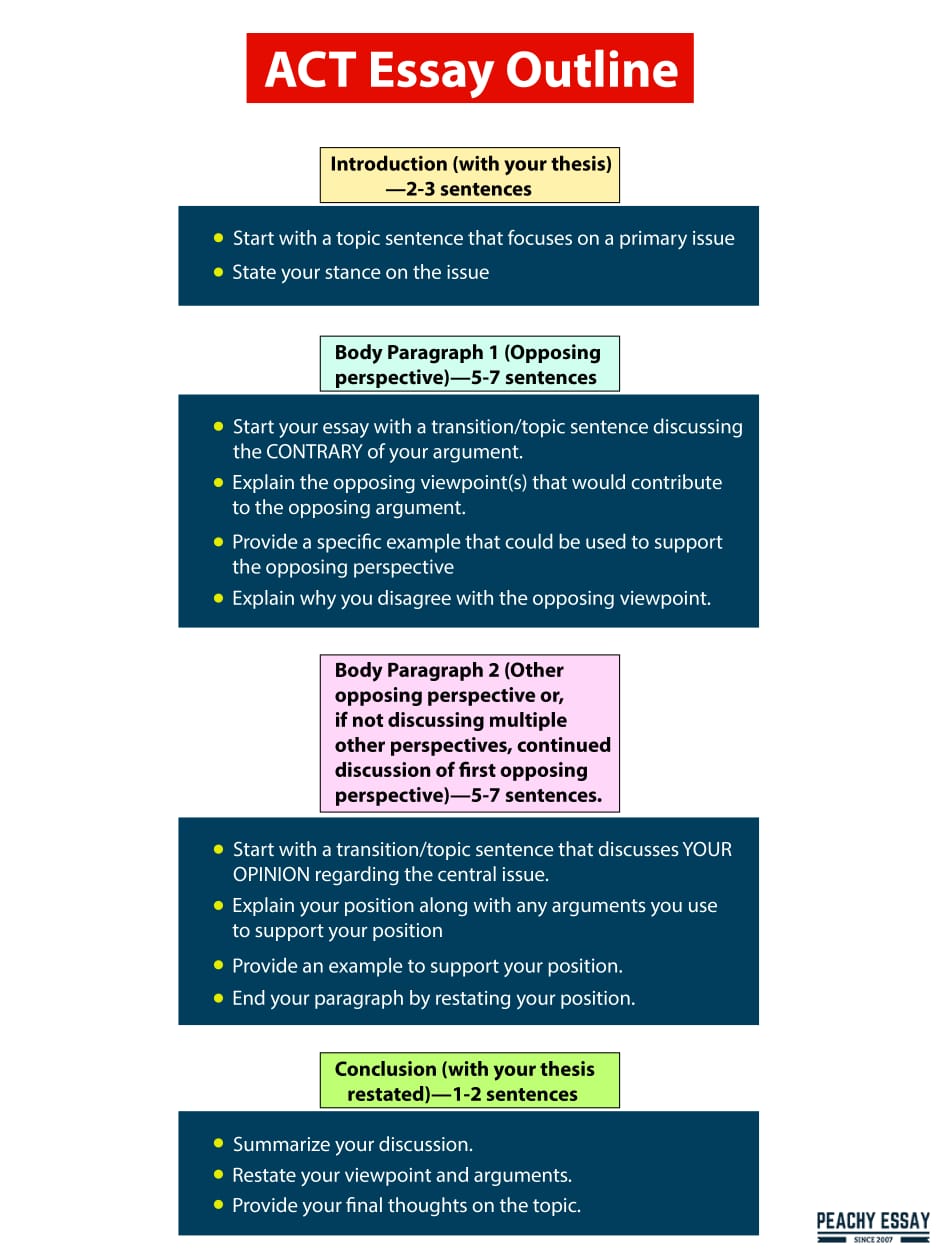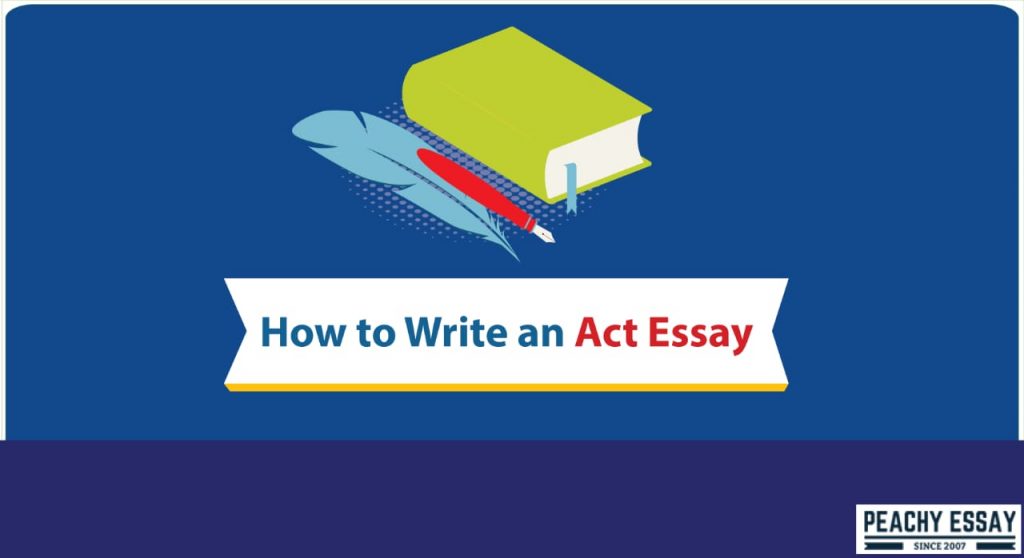Although many students can do an acceptable job with most regular assignment essays, the ACT essay is particularly challenging. ACT essays are a crucial step in the college application process, and their quality determines whether a student gets into their dream school or not. As a result, it is understandable that students will struggle with this assignment.
A great way to approach an ACT writing test is to prepare and organize before you get on the table to create the essay. An ACT essay is a time-constrained assignment, which is why you have to have a detailed approach before you sit down to write.
In this guide, you will get in-depth information on how to write an ACT essay. Read on to learn more!
How to Write an ACT Essay
Here are the steps for writing an ACT essay.

Read the prompt
The essay prompt typically includes up to three perspectives. Although you are not required to agree with any of the perspectives, you must have a deep understanding of the topics and know how you relate to each perspective.
One of them must match your perspective closer than the others, so choose wisely.
If you are running out of time, you cannot add your view as your fourth perspective. Instead, it would be best if you focused on finding the perspective you can relate to most, and that will support your arguments. This will give you a strong foundation for a good ACT essay.
The brainstorming of the evidence
Your ACT essay is ultimately meant to show the connection between your perspective and at least one perspective provided in the assignment. However, the only way you can make a convincing case is to provide plenty of evidence so that you will need at least a few pieces of evidence for your essay.
In this stage, you should simplify your viewpoints into short phrases and notes instead of whole sentences. Since your viewpoint is highly malleable, do not get too invested in writing before you have finalized the perspective you wish to take. You can find convincing evidence from the following source:
- Essay prompt: Upon carefully reading the prompt a few times, you might be able to discover plenty of examples that back up your perspective on the subject matter.
- Personal experience: It is helpful to use a story or example from your life or the life of a person you care about to strengthen your perspective. And the best thing is that those stories or examples don’t even need to be true to work.
- Statistics: You can use statistics in your essay to add credibility to the perspective. Statistics do not have to add value to your essay perspective. Even made-up statistical figures can enhance your narrative.
- History: In your essay, if there are historical events that could support your opinion, you should always incorporate those details into your paper. The historical information does not have to be 100% accurate, but it has to be pertinent.
Brainstorming other perspectives
If you decide to defend a perspective, all the other perspectives must be covered as well, only this time, you must argue against those perspectives.
There is usually no need to prove your point using both of the opposing points of view — in most cases; a good essay will be sufficient if you provide arguments against just one perspective.
Organizing your essay
After deciding on the main points of your essay, the next step is to organize it and give it the correct structure. The classic essay format for the ACT paper includes an introduction, three body paragraphs, and a conclusion.
The beginning of your ACT essay should always end with the thesis statement. You will then use it throughout the paper to support your argument. You can write out the thesis statement in a rough draft if you cannot spell it out perfectly at that time.
Writing an introduction
In an ACT essay, the introduction will not be as long, but since it will be the grader’s first impression of the essay, it must leave the right impression. The introduction must be precise and highly relevant to the paper.
The best way to introduce your piece is with a hook or an interesting introductory sentence that will instantly elevate your writing. However, it will likely be difficult to articulate something meaningful and witty during a stressful assessment. The introduction can always be left blank so that you can return to it later.
A thesis statement is one of the most important parts of the introduction because it clarifies your perspective and its relation to other perspectives from the essay prompt. The thesis statement must be included in the introduction.
Writing body paragraphs
To build a cohesive narrative in your essay, each body paragraph should refer to the thesis statement. It should contain support of the opposition’s contention and then a counterargument to further back up the perspective you chose earlier.
If you compare your perspective with one or two perspectives presented in the essay, the content of the body paragraphs may differ. However, the general structure for writing each paragraph remains the same: it should remain relevant to the thesis statement, the article prompt, and each other. A strong case must be presented to prove your point.
Conclusion
Conclusions to ACT essays do not have to belong: they typically don’t need to include more than one sentence, but they need to be convincing sentences that capture everything you’ve written so far and demonstrate to the audience that your position is well-supported.
Revision
With around 3 to 5 minutes left, you should complete your ACT essay. The best way to utilize that time is to ensure your writing is absolutely flawless. Carefully review your essay and correct any possible grammar and spelling errors.
If some of the words you picked for your essay are unfamiliar to you, it is still possible for you to enhance your vocabulary.
If everything is done right, you will have a winning ACT essay to boost your chances of success. Even if you still have plenty of time, prepare for the writing portion of the ACT within the allotted 8 minutes. You will then have sufficient time left to finalize your essay before it’s due.
Elements of an ACT Essay
For a good ACT Writing score, your essay needs the following elements.

An Introduction
Your opening paragraph will be the first thing your reader meets, so it’s a good idea to get a good start out of it. Don’t just dive right into the essay; introduce your perspective and how it relates to the other points you’ll be discussing.
Although the introduction does not have to be written at the start of the essay (you can still leave a few lines blank and come back to it after writing your example paragraphs), it must be included.
Thesis Statement
You must take a position on the issue provided in the prompt paragraph and articulate it clearly. I recommend using one of the three perspectives the ACT provides you as your perspective/position; you can write your own perspective, but you’ll spend less time writing it.
Your thesis statement (discussing your perspective) should be the first sentence of the introduction.
A Discussion of the Relationship between Perspectives
Discuss the relationship between your perspective and one other perspective in your essay. Be sure to point out any pros and cons when you don’t agree with them to demonstrate your grasp of the complex issue.
Examples of Reasoning to Support Each Point:
Your arguments should be backed up with reasoning or specific examples. The reasoning should be given in the same paragraph as the argument. For example, if you argue that globalization leads to greater efficiency, it is important to include the rationale for your argument in the same paragraph.
You need to actually get into why you think what you are saying is correct, rather than say “Because of freedom” or “Because of ABC.”
Clear Organization
Instead of discussing multiple points in one paragraph, we recommend that you discuss one perspective per paragraph. This will simplify the organization and make it easier for the essay’s readers to follow your reasoning, which is always a good thing.
ACT Essay Outline
The following format should be used in your essay

How to get an Outstanding Score in your ACT Essay
To get an outstanding score, you must stand out from the crowd. Here’s how to do that:
- Use less-obvious examples in your ACT essay
Graders shouldn’t penalize you for a dull example, as long as it’s good. But always remember to write for the human reader!
In other words, if the grader reads 50 papers on the civil rights movement in one go and then gets to yours and finds yours on a totally different subject matter, he or she will pay attention. Not only that, but it will also make it harder to compare your essay to others. If everybody writes about the same topic, perhaps some will do it better than you, but some may not. So don’t compare yourself to others. Be original.
Again, this does not mean that such topics can’t be discussed, but only if you’re going to take very specific examples of those topics to demonstrate your knowledge. But if you can come up with something significantly less obvious, don’t leave it out.
- Provide your own perspective on the ACT essay, but only change it slightly
You can get a perfect score by agreeing with one of the three presented perspectives. That is the best strategy for the vast majority of students to not get completely off track and ruin your grade.
However, if you believe yourself to be an excellent writer, you might find it even more fulfilling if you adjust the prompt to suit your own creative style. In most cases, the most straightforward method of accomplishing this is to narrow one of the perspectives.
For those who are ACT-writing superstars aiming for a score on the 11–12 range, take these key pointers to heart, and start practicing with ACT writing prompts.
The ACT prompt for the new essay is tough; however, practicing with sample prompts and coming up with arguments on the fly will help! To get an idea of the test-day experience, practice the essay on its own and take the Practice Test as well.


